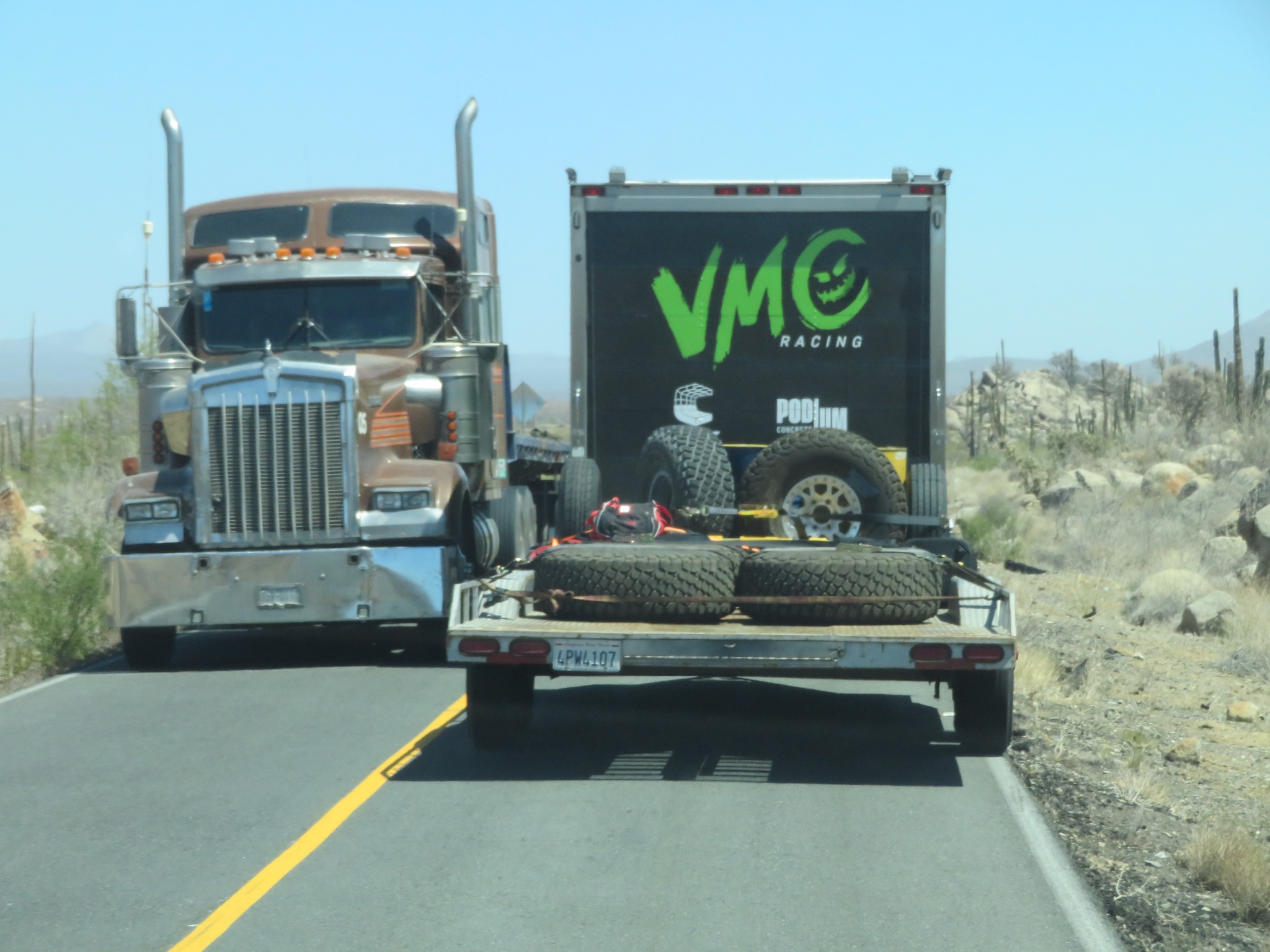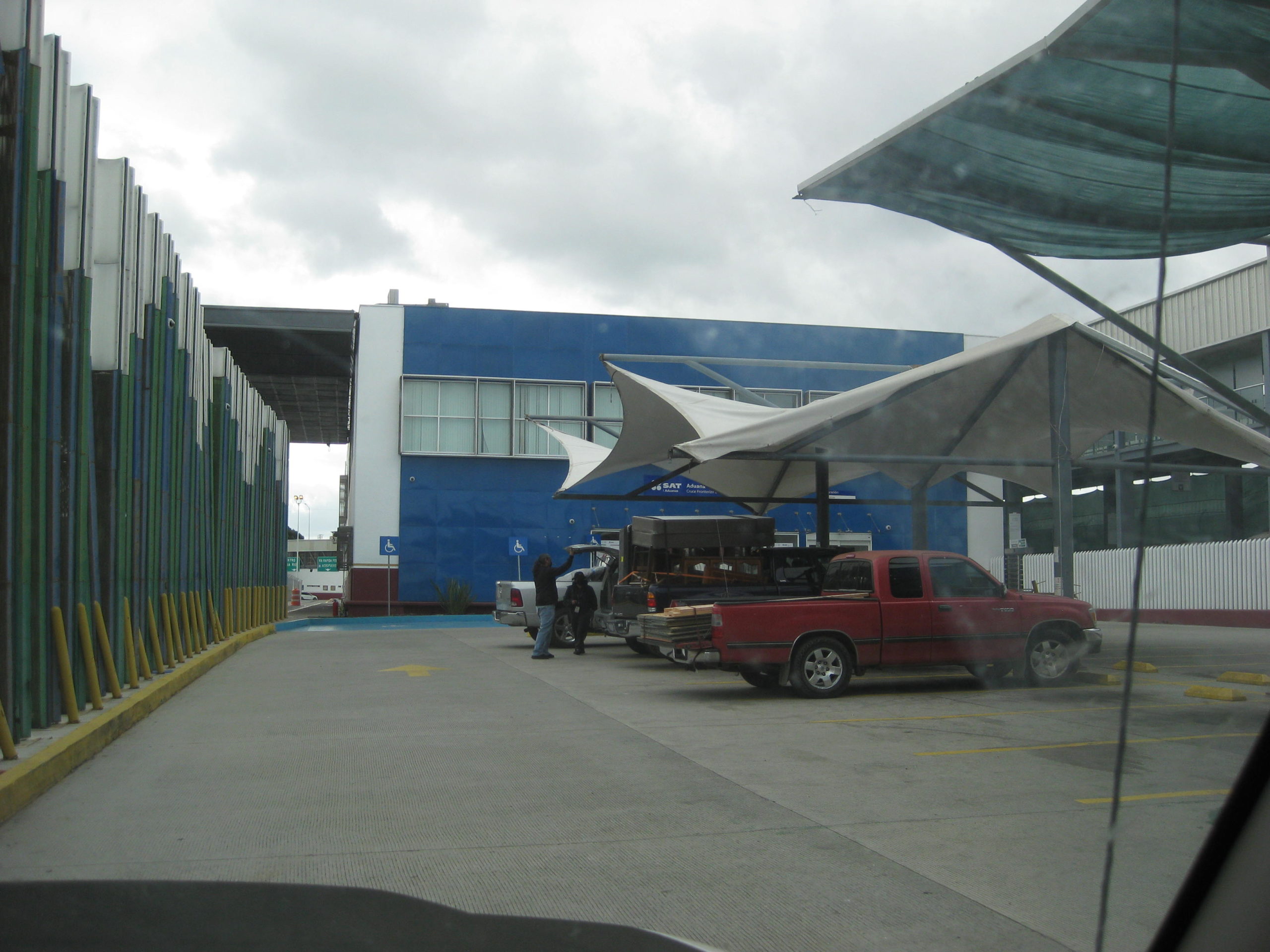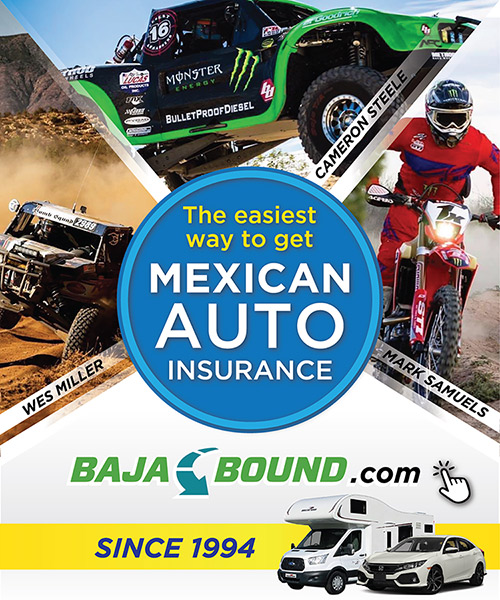Plenty of information about this is on the Internet, some of that may even be correct!
Let me calm your nerves if this is your first trip to Baja, by automobile… It is pretty easy to deal with the formalities.
You are allowed to bring anything you personally use for traveling and camping. Bringing camping food into Mexico has never been questioned (unless there is some new restriction such as there was for beef during the Mad Cow crisis of a few years ago). Most fresh and canned foods can also be purchased in Mexico. Super markets are in Ensenada, Tecate, Mexicali, or San Felipe, as you travel south. If you have prescription drugs, use the original pharmacy bottles with your name on them. If you bring a dog, have its current rabies vaccination certificate (rarely required)*. Dogs must be secured while driving and not allowed to be loose in the vehicle or truck bed. If you have children along from another family, a notarized permission slip from their parents should be with you. An authorization for any emergency medical needs, may be wise.
*New U.S. rules announced that will soon require pets to be micro-chipped and have a health certificate. More new dog rules on Aug. 1, 2024
You are not allowed to bring guns, ammo, marijuana (even medical marijuana), or other recreational drugs into Mexico! If you are a gun owner, check carefully for any bullets or shells hidden in any of your vehicle’s compartments. No bongs or other marijuana smoking devices, either. Don’t ask for trouble. On your drive in Mexico, you may come upon a military-run checkpoint. Here, vehicles may be searched for the above mentioned items. Keep cash, valuables, phones, GPS, cameras with you as you exit the vehicle. You may stand nearby to observe the soldiers going through your vehicle.
Before your trip, buy [and print out] a Mexican auto insurance policy (online). Your U.S. or Canadian policy has no liability coverage for Mexico, and the theft or collision portion may be limited, such as for the distance south of the border. Inexpensive Mexican auto insurance for tourists is available from many sources. I use Baja Bound, which sells only top-rated insurance brands. They are ones that cover any collision repairs needed, performed back in your home country. The Baja Bound staff are superb people who go out of their way to help clients should they have issues. *If you are towing, you must include that detail when buying the insurance. For long or frequent trips, an annual or 6-month policy can be far cheaper than multiple-day policies. Never drink and drive, or use a cell phone while driving. Click on the ad at the bottom of this page to get a free quote.
Many highways are very narrow, with no shoulders. They require your full attention! The following two photo are of Mexico #1, south of San Quintín. Thanks to ‘jrbaja’ (left) and Barbara Rainey (right):


Mexican Immigration (INM) rules REQUIRE every U.S. and Canadian citizen to obtain an FMM (‘tourist card’) form when you enter Mexico, no matter for how long or for how far south you go*. This paper is like a visa, but technically not a visa. To get one, you must have a valid passport or passport card while in Mexico.
*NEW: In 2023, a 72-hour, FMM border zone exception was announced on a government website: ‘EmbaMex’.
Some overseas visitors to Mexico may need an actual visa. Contact the Mexican embassy or consulate in your country to verify.
While I do not recommend doing so, you can obtain an FMM online. However, you still must stop at the border to have it validated (stamped). You do that at the same desk you get one at. In addition to the online FMM, you must also bring the printed sales receipt from the online purchase. You must use the border crossing you specified and you must cross on the day you specified. If you cannot do all of those, you will need to pay again at the border. There’s almost no time savings by getting one in advance, other than a few minutes. Too many have reported the INM officials wouldn’t accept the online one. Save your money and do it all at the border.
1) As you near the border, look for a lane marked ‘something to declare‘ (even if you are not declaring anything) as this parking area is also for the INM desk, which is inside the FIRST building in Mexico. Usually, this parking is before the electric gates that meter cars through. Tecate is different. The parking area there is after the electric gate and on the first street to the right, but it is a one way street going the wrong way, so you go around the block to those parking spots, which may be blocked by a cone that can be moved. Some people park on the U.S. side and walk into Tecate, Mexico to get their FMMs. INM is open when the border is open.
2) Park, and walk into the building, with your wallet and passport. Look for the INM desk (Tecate has turnstiles you go north through to get to the building). Present your passport and fill out the FMM (bring reading glasses if you use them, the text is small). You then may be instructed to walk over to a bank teller to pay, then return back for the stamping of the form. If the bank teller is not there, the INM agent can accept the money*. Debit/credit cards are accepted, as well. The FMM can be free for visits of 7 days (6 nights) or less. For up to 180 days, the fee is 717 pesos, about $40 (U.S.) dollars, currently. You keep the FMM until it expires, for multiple auto trips south. Unlike the flying FMM, it does not get returned to INM when you leave Mexico. *In 2024, only debit/credit cards can be used to pay at some borders (rumored to keep officers honest). Be prepared for the fee to be higher than in 2023 when the above was written. More updates, below.
3) Return to your car, merge into the flow of traffic entering Mexico, and begin your vacation. If you get a red light at the electric gate or if officials motion you to pull over, it is for a random search of your vehicle and usually takes only minutes.

I have covered a few of the major border and driving details that we all experience. Many do not give these rules much attention as they travel so often into Mexico. Also, many travelers do not bother getting the FMM at the border, taking a risk that they will never be asked to show it, or simply don’t know the rules. If a random INM inspection pops up, far south of the border (as they have before), you will be made to turn back north. That could mess up your vacation. Take a few minutes to respect the rules of the country you are visiting.
*2024 FMM details from Baja Bound Insurance: https://www.bajabound.com/before/permits/chaparralimmigration.php
HOW TO DEAL WITH BAD COPS IN BAJA. (They are rare but it happens)
Mexicali shake down..
Our race team crossed on November 8th to head to San Felipe for the night, in route to La Paz. As soon as we crossed the border the local cops had a choke point set up to funnel traffic down to one lane.
One guy picked me out and had me pull to the curb. He used his phone to translate that I needed to pay a $300 US dollar ticket for no front plate. He proceeded to tell me that he knew we were in a hurry to get racing so I could just pay him. Several times he pulled out his handcuffs and twirled them on his finger like he was going to cuff me.
I told him I’m retired and had all the time in the world and that we could go to the station anytime he was ready. He kept telling me the station was a long was away. I got out and started cleaning out my passenger seat, he asked why I was doing that. I told him so he could ride with me to the station. I then sat on the curb and waited. He gave in and sent me on my way.
This was my first shake down in twenty years of Baja travel. Looking back, I should have turned my phone to point at my window (it’s in a holder on the dash) and let him see me recording.
NOTE: REMEMBER TO NEVER ACT SCARED OR BE IN A HURRY. DO AS ADVRIDER DID, INSIST ON GOING TO THE STATION.
Mexico uses the metric system, distances on signs are in kilometers and speed limits are shown in kilometers per hour. 1 km. = 0.62 mi. Common highway posted speeds are 80 kph (= 50 mph) and 110 kph (= 68 mph). Gasoline is sold by the liter. 1 liter = 0.26 gallon, 20 gallons = 75.7 liters. There is a long gap in reliable gas stations south of El Rosario (Hwy. 1) or San Felipe (Hwy. 5) to Guerrero Negro (over 200 miles), so top off your tank at either location. Gas is usually available at the stations in Bahía San Luis Gonzaga (Hwy. 5), Bahía de los Angeles (40 miles from Hwy. 1), and Villa Jesus María (Hwy. 1). Gasoline is also sold out of cans from ‘independent’ vendors on Highway 1, at Cataviña and the L.A. Bay junction, although they do add about $1.50/ gallon to have it there for you. Many towns without a gas station have people who sell gas from cans, if you can’t make it to a station. These include Punta Prieta, Santa Rosalillita, San Juanico, and San Miguel Comondú. As this is an unauthorized business activity, you may need to ask a local, as these operations may not advertise with signs.
In July 2024, the Mexican pesos have a value between 17 to 18 per U.S. dollar (1 peso = ~6 cents), bouncing from 16 to 21 to the dollar the past few years. U.S. dollars are accepted most everywhere in northern Baja California and may locals use dollars in their daily transactions. However, you may get a better exchange value if you change dollars to pesos at one of the exchange houses (called a casa de cambio) located before crossing the border. This avoids confusion when buying gasoline or other items in Mexico. I do not recommend using credit cards where stations offer that. Cash is king in Baja California.
More border crossing info from the Baja Bound Insurance website: https://www.bajabound.com/before/permits/ https://www.bajabound.com/before/permits/crossingtheborder https://www.bajabound.com/before/permits/visa
Have more questions? Ask them on our Facebook group: https://www.facebook.com/groups/vivabaja Take off your watch and let time walk, not run. No hurry, no worry. Be flexible with your trip plans. Some places may not be as good as others on a trip, so move on or explore a new place. Remote ranches and fish camps are where you find some really super people who will welcome you and treat you like family. No matter what the problem, everything works out in Baja. Smiles go a long ways in Mexico, and be humble. Remember, you are not in Kansas anymore!
The final map from the Auto Club was made in 2010. While it is not up-to-date with the newest paved roads, it does show mileages and gasoline sources, both are helpful to know! The Benchmark Baja Road Atlas has up-to-date maps, gasoline locations, and kilometer marker locations. Being one of the Baja Atlas editors was such a joy for me to see produced! The digital Benchmark Baja Atlas map app from Avenza works without cell coverage at showing your exact location anywhere in Baja California.
See: 2010 Auto Club Map of Baja California (the final edition)
Buy: 2023 (second edition) Benchmark Baja California Road & Recreation Atlas
Buy: 2021 Benchmark Maps Baja California Road & Recreation Atlas, special price
My 31 Baja Road Guide Maps of 2018-2021 do not show as much but may be easier to navigate with and includes the highway kilometer signs at key locations: 2018-2021 Road Guide Maps by David Kier
Look for my Baja Bound Road Guide, coming soon. Some sample pages

CLICK HERE FOR AN AUTO INSURANCE QUOTE:
What can be brought back into the United States:
With many so many changes in recent years, I strongly recommend you consume all your food or donate it before reaching the border. The military inspection checkpoints gladly accept any goods you have such as fresh fruit, vegetables and meat. Even if the produce or meat was purchased in the U.S., once it enters Mexico, it is considered Mexican by the U.S. border officials. Not allowed into the U.S. list includes any pork products, including packaged sandwich meats; Uncooked chicken or raw eggs; Avocados, Oranges, Papayas, Mangos, and some other produce, are not allowed into California, USA.
The list below includes what may be brought back with you, if clean, soil free, and declared.
The most recent list I have seen is this one:

What to do if a U.S. citizen dies in Mexico (from Discover Baja Travel Club)